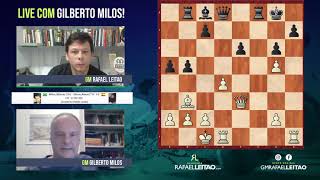Would you be able to identify the mistake in this post’s illustration?
It is quite common to make gaffes when we start learning something, and that is not different in chess. To avoid those embarrassing situations, let us review some of the biggest gaffes that a chess beginner could ever make, and let us understand how to avoid them. Shall we?
Biggest Mistakes Made By Chess Beginners
PLACING THE KING AND QUEEN IN THE WRONG SQUARES
It is common that beginners misplace the king from its correct initial position, putting it in the queen’s square, and vice-versa. In order to have the pieces deployed in their right initial squares, we must remember the rule: the white queen goes in the white square, and the black queen goes in the black square; thus, the white king goes in the black square, and the black king goes in the white square.
TOUCHING A PIECE WITHOUT INTENDING TO MOVE IT
In chess, if you touch a specific piece, you can only move that piece (the “touch-move rule”). The exception is the “j’adoube” (“I’ll adjust”), which is when a player simply adjusts a piece on the board, but only when it is his or her turn to move (surprisingly enough, experienced players sometimes make the gaffe of adjusting a piece when it is the opponent’s turn to move), and only by saying “J’adoube” or “Excuse me”, expressing your wish of solely adjusting one piece. That makes players think well before choosing a move. Pulling back after touching a piece is considered a gaffe, because it shows that the player hesitated and did not measure his or her move correctly. In other words, it demonstrates lack of confidence. Moreover, it is important to note that touching a piece and not moving it is illegal. Your opponent might call it, and the arbiter can make you move that piece, or he can apply other suitable penalties.
ANNOUNCING A CHECK
Is it really necessary to tell your opponent that he or she is in check? Specially in tournaments, that is considered disrespectful towards your opponent’s intelligence and ability. It conveys the impression that he or she cannot realize by himself/herself that you are carrying out a straightforward attack to the king.
NOT RESIGNING A GAME
Many beginners believe that it is rude to resign a game. However, the big masters always resign a game when they realize that there are no more possibilities of saving it. The great majority of games between professional chess players do not end in a checkmate. Virtually defeated players would rather abandon the game than waste the opponent’s time by playing without any need. Resigning a lost game shows respect for your opponent. But how does one do it? In general, chess beginners tip over their own king in an act of surrender, whereas the right thing to do is to congratulate your opponent, stop the clock and sign the official score sheet.
SETTING UP THE CHESSBOARD ON THE WRONG SIDE
Maybe one of the most serious mistakes in chess, and one of the biggest gaffes, may be setting up the chessboard on the inverted side. That is the exact mistake that is shown in this post’s illustration.
The first square to the left (a1) must always be black. Misplacing the correct side of the chessboard when setting it up makes the game illegal and impossible to be recorded under the parameters of standard notation. That mistake is probably the most often noticed when a chessboard appears in a movie or a soap opera, or when we see a board displayed in a store window. How many times have we already witnessed a white a1 square, for the horror of those who truly love our art?
When you are a beginner in chess, it is common to make a few gaffes. Therefore, do not worry so much if you have already done one of those things. It is important not to repeat gaffes! Now that you know which ones they are, learn some key terms in chess, in order not to feel lost when you are watching games.
Is there any further question? What was the biggest gaffe you have ever made? Share your experiences in the comments!
Visit our YouTube Channel!







Thanks for detailing some common mistakes made by beginning chess players. I appreciate that you mentioned that it's important not to touch a piece if you're not going to move it. I think if you were just starting out it would be smart to take some chess lessons so that you could better learn what to do and what not to do. https://www.chessteacher.com/chess-lessons/